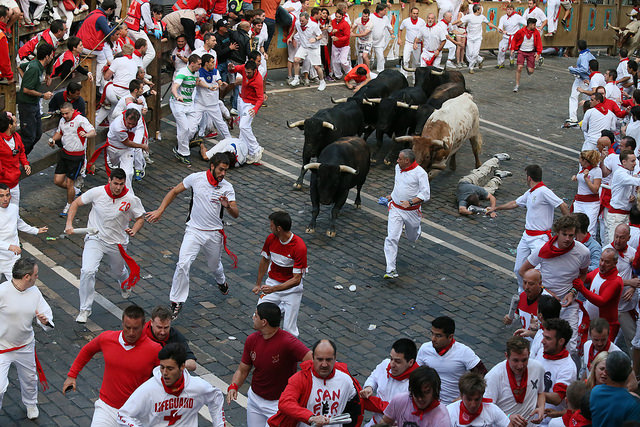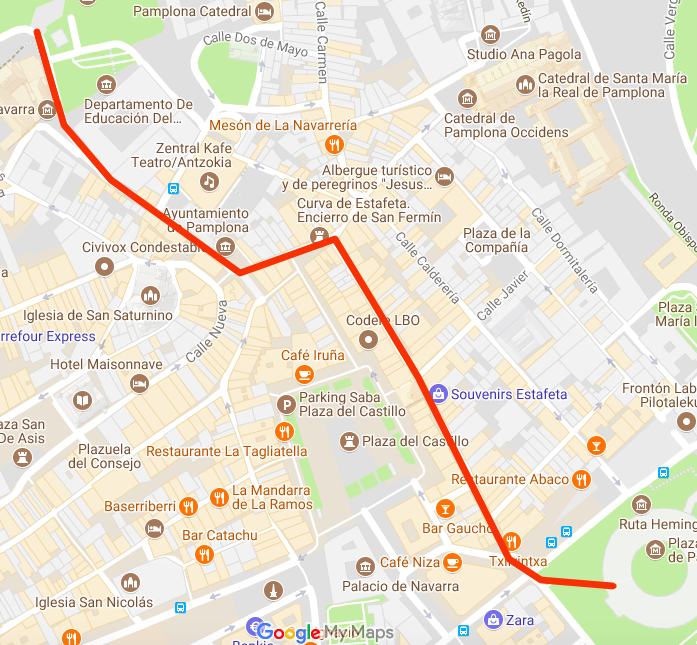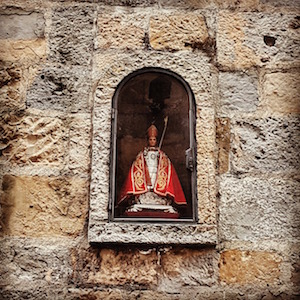Pamplona, the Running of the Bulls, and San Fermines
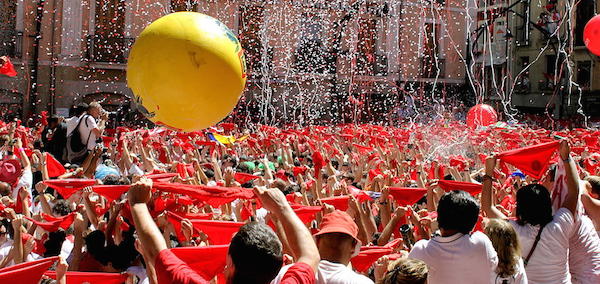
Partying in the streets at San Fermines goes all day and all night. (via Wikimedia Commons)
The eight-day festival and series of events surrounding Spain’s famous “Running of the Bulls” takes the prize as the most exciting event I’ve participated in during all my years of jet-setting around the globe. As anyone who follows my continuous adventures on Instagram stories knows well by now, I live a pretty exciting and fun-filled life. But out of all of my crazy adventures, there’s no doubt that Pamplona, Spain takes the cake and I will undoubtedly be returning to the San Fermin festival and the Running of the Bulls event there every year from now on.
It’s. Just. That. Amazing. Here’s why…
My first time experiencing San Fermines (as the locals call it) and the Running of the Bulls almost didn’t happen. I was still in Toulouse at the time and, well, as most who follow my adventures on FB know well I tend to miss a lot of flights when I’m traveling because I’m simply having too much fun or out too late or what have you. So this is yet another story that starts with me missing not one but two flights to Spain from Toulouse in the same day. I’ll spare everyone the details of why I missed my first flight, but let’s just say it involved an unattended drink, a group of naked people, a suburban roundabout, two nonchalant French cops, and oversleeping by 10 hours.
So yeah, that flight was missed AF. But my second flight to Pamplona I had just re-booked that same day for that same night and I missed that one too simply because I underestimated the time it would take to get to the airport. I typically check in online and don’t check luggage, so getting to the airport about 45 minutes before a flight usually works just fine. But this time I just had an extra delay or two that got me there slightly less than 30 minutes prior, and I was flying a cheapo Euro airline so they wouldn’t budge one bit about letting me on the plane.
The bigger problem now was that I was the one who had booked the Airbnb in Pamplona and I had several friends meeting me there that evening to begin our bucket list trip together. Ultimately, I had to coordinate with the Airbnb owner to meet them without me there to pick up the keys, then I had to stay another night in Toulouse and take a freggin’ 8-hour bus from Toulouse to Pamplona with a connection in San Sebastian the next day.
While busses are usually a great way to travel around Spain, I was flustered that my quick comfy flight turned into an 8-hour uncomfy bus ride. I did at least get to take in a small taste of San Sebastian, a seaside Basque city on Spain’s northern coast that people rave about. I really need to go explore it more, as well as nearby Bilbao and the rest of Basque country, but that day I only had about an hour and a half “layover” there so I took the opportunity to wander around near the bus station and shop for the obligatory San Fermines outfit that I would need once I arrived in Pamplona.
No one really knows why or when San Fermines participants started wearing the traditional attire that both locals and tourists don for the entire period of San Fermines in Pamplona, but the fact is that today it has come to be an integral part of the experience. Upwards of 99% of people in the streets of Pamplona during San Fermines will be wearing this outfit, and you definitely need to be as well unless you want the God of Authentic Travel Experiences to strike you down.

Everyone in Pamplona wears the traditional red and white outfit during San Fermines.
The outfit is cheap, simple, and easy to assemble. It consists of a white t-shirt, white pants (trousers, for you British folk), a red sash worn around the waist like a belt, and a red pañueleco (bandana or kerchief) worn around the neck. The all-white t-shirt and pants are easy enough to get anywhere and bring, or you can buy them in Pamplona once you arrive. But you’re best waiting until you get to Pamplona to acquire the red accessories because they’re a little specific and the ones sold in Pamplona usually have the city crest or some other event symbol on them and that will be much better to have as a keepsake than just any old piece of red cloth. Trust me, you’ll look snazzy AF with your official San Fermines sash and pañuelico from Pamplona!
One thing you will for sure need to get ahead of time is your accommodations in Pamplona. While you can stay further out in the burbs if you want in order to get a cheaper place, it’s really worth it to splurge a tiny bit and find someplace more central to the festivities. The nature of San Fermines is that you wake up, roll out of bed, put on your red and white outfit, and wander out into the streets to start eating and drinking all day. When you’re tired, you’re going to want the ability to take a quick siesta and you don’t want to have to spend an hour on buses in order to do that and another hour to come back. It’ll interrupt your vibe, your groove, and your experience. And it might even make you not want to come back out later in the night when things really get going downtown.
My friends and I had talked about doing the Running of the Bulls for months. As summer approached, we were still just talking about it and hadn’t booked anything yet. We didn’t end up booking an Airbnb until just under two weeks out and we were still able to find a number of places that were reasonably priced and extremely central. We ended up staying in two different Airbnbs because one was only available for the first few days, so we had to switch apartments halfway through our stay. Our second flat was a little more expensive but it was literally right there in the middle of all of the action in the center of the city and we were more than happy to be paying a little more to have a home base right in the middle of it all.
One important thing to note about San Fermines is that the party in the streets literally goes on all day and all night… for eight days. Restaurants, bars, cafes, and shops fling their doors open wide and there’s always a sea of red and white-clad festival-goers moving in and out of them and up and down the streets all over the city center.
There are also roving groups of musicians and performers that will stop randomly and serenade a block or plaza and then move on to the next and do it again, so there’s a constant flow of activity and entertainment throughout the day and night too. If the song being played is a well-known one, expect locals to burst out into traditional dances or join in the singing. Spontaneity is also a major theme in Pamplona during San Fermines.
It’s hard to describe a typical day at San Fermines primarily because it’s hard to determine when a day begins and when it ends, so let’s just pick sunrise and go from there. When the sun comes up, you’ll often still be out enjoying the festivities in the streets of Pamplona. Spain is a very late country to begin with, so staying out late and sleeping in late isn’t that unusual at all for the socially active. So come 5 or 6am, parties will still be going on in some streets and bars and the street cleaners will be out and about to clear the zillions of bottles and debris from the night before. Many people party through the night during San Fermines because they want to stay awake for the highlight of the day, the Running of the Bulls, which occurs every morning at 8am throughout San Fermines.
Starting at about 7am, thousands of people begin to line the streets along the Running of the Bulls route in the city center. If you had found your energy fading around 5 or 6am, you’ll definitely get a second wind and a fresh supply of adrenaline during the 7 o’clock hour as the energy level begins to build toward the start of the daily run.
Pamplona city officials, especially the Spanish police, take organization, crowd control, and safety very seriously. They fully acknowledge and plan around the fact that San Fermines is all about celebrating and drinking and socializing and generally having a wild crazy fun experience, but when it comes time for the Running of the Bulls the Spanish have become quite spectacular at maintaining order without ruining the fun and excitement of the event for participants and spectators.
About an hour or so before the run, police will begin barricading off the borders of the run route and plucking out anyone who appears to be too intoxicated to participate. They, along with anyone else not wanting to do the actual run, are directed to the other side of the barriers to continue partying and watch the run. With the proliferation of smartphones, GoPros, selfie sticks, and other self-filming equipment over the past 10 years or so, police now go through the crowd remaining inside the run route and pat them down for contraband.
If you’re participating in the run, filming yourself or filming at all while it’s actually going on is now prohibited, and for good reason. Anything to break your concentration or cause you to impede others in the crowd from running for their lives during the run itself is a potentially life-threatening safety hazard, so it’s best to respect this prohibition. You can take all the selfies and videos you want before the run and after the run in the bullring (more on that later), but it is seriously not cool at all to try to break the rules and take photos or video during the actual run if you’re participating as one of the runners. Those on the sidelines can obviously film and photograph to their heart’s content. (For all the deets on participating in the run see the related article entitled Complete Guide to Participating in the Running of the Bulls)
Speaking of rules, about 15 minutes out from the start of the run the city will begin playing videos on huge outdoor screens that go over the rules for those participating in the event and provide other essential info for runners. Paying close attention to this safety video is important for two reasons – one, it could save your life, and two, following the rules prevents you from being expelled from the run route by police.
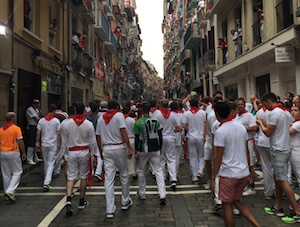
Thousands of people pack into the run route for the Running of the Bulls as tens of thousands more look on.
As the moment of truth approaches, a small ceremony of sorts takes place at the very beginning of the route near the gates of the bullpen. Locals will gesture towards a statue of San Fermin himself and sing a traditional song praising the saint and asking for his blessing and protection during the run. It can be neat to watch this on one of the days, but for the rest of the time I’d strongly recommend placing yourself further down the route so that you can see more than just the lightning-quick start. Also if you’re running yourself, you definitely want to be further down the route because it’s safer and more fun.
At 8am sharp, the gate of the bullpen is flung open and the first of four rockets is fired into the air to signify the exit of the first bull into the streets. There are typically 12 bulls in total that run, six of which are the fierce ones that will be fought later that evening by matadors in the bullring and six additional oxen whose purpose is to prod the more fierce toros along the route and toward the bullring at the end. Once all 12 bulls are out of the gates, a second rocket is fired into the air and the gates are closed. Now the real excitement begins.
The original functional purpose of the Running of the Bulls was to move the bulls to be fought in that day’s bullfight from outside the city across the city center and into the bullring. Now they go from a corral near the river along the same route to the bullring where a crazy (and highly entertaining!) spectacle takes place once runners and bulls start to reach the arena at the end of the run. But again, more on that shortly.
The entire Running of the Bulls route is only 875 meters long, or just under a kilometer and just over a half-mile. (For more information on the exact route see the related article The Running of the Bulls Route Map) The actual running itself usually takes only about 4-6 minutes because those suckers are quite fast, far faster than their human counterparts. If all the bulls are able to stick together in one pack, they typically complete the run in this short time period. But very often one or two of the steers will get separated from the pack or get distracted along the way and fall back causing the full run to last in the range of 7-10 minutes or even slightly longer on rare occasions.
During these harrowing minutes, runners inside the route make a mad dash forward in an attempt to outrun the bulls to the end of the route and on into the bullring. Since the route is quite crowded and since the bulls are faster than the runners, a natural mix of panic, adrenaline, and excitement hits the runners as they see the first of the bulls approaching. The crowd is – or should be – already moving forward as soon as they hear the first rocket, and especially by the time of the second rocket. Within minutes, and sometimes seconds depending on where along the route you are, the bulls will come up from behind charging toward you at what seems like light speed.
Bulls are not naturally aggressive towards humans, but they are instinctively defensive creatures and they can get very aggressive when they perceive a threat. During the run, all they’re trying to do is get to the bullring as fast as possible and all of the strange creatures clad in red and white blocking them are perceived as an annoyance that they just want to move out of the way and run past. Very often runners try to taunt the bulls or reach out and touch them while they’re running alongside, and this comes across as a threat to which they sometimes respond by trying to shove them out of the way with their horns. A bull that also feels trapped in a doorway or at a corner can also begin to panic and feel threatened by anyone around it and respond accordingly.
While defensive aggression by the bulls during the run can and does cause a few very serious injuries every year, injuries from the bulls themselves are often few compared with injuries from falls and trampling by panicked runners. That’s why you really have to have your wits about you (especially your non-intoxicated wits!) and be very situationally aware during the entire short run. Your natural instinct is to look behind you to see where the bulls are, but the mass of people doing this and trying to run forward at the same time frequently causes lots of trips and falls during the run.
Event officials warn in the videos at the beginning that the safest thing for runners who fall to do is to stay down and curl up in the fetal position with your hands and arms covering and protecting your head until the bulls and the crowds pass and someone comes to get you and tells you it’s safe to get up. If you fall in the middle of the street during the run and try to suddenly stand back up, you could very well find yourself staring a startled charging bull square in the eyes – and the horns. Even if you don’t fall, though, you have to look out for others who have fallen so that they don’t trip you too.
Since Spanish authorities first started tracking deaths and injuries during the annual event in 1922, only 15 people have been killed out of the hundreds of thousands of people who have run with the bulls in Pamplona. Every year the crowd of daily runners consists of a mix of experienced locals who take the event very seriously and first-time tourists who are in it for the one-time thrill. The more common occurrence is injuries ranging from simple cuts and fractures to serious concussions and gorings. On-the-scene medics and local hospitals treat dozens and dozens of these types of injuries during the eight-day span. But as mentioned previously, most of these injuries are not caused by bulls but rather by the carelessness of runners amid the density of the panicked moving crowd.
Since the point of the Running of the Bulls is to actually drive the bulls toward the bullring and on into the corral there for keeping until that day’s bullfight in the evening, Pamplona’s Plaza de Toros (the name of the bullfighting arena) is the finish line for runners and bulls alike. Because the entrance to the arena is much narrower than the street leading up to it, the final dash through the bottleneck entrance into the arena can be one of the most dangerous parts of the route for runners. In fact, the first time I did the run myself this was where I had my closest call with a bull.
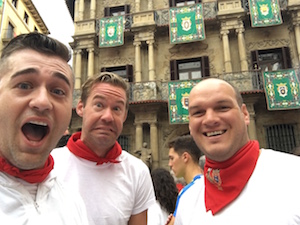
Los tres amigos getting ready for their first Run with the Bulls.
I had done a little homework prior to the morning I did the run and figured out that I wanted to already be about halfway down the route when the first rockets went off and the bulls started their run. The two friends who did the run with me and I were all super excited but also super nervous. As the minutes ticked down towards 8am, our levels of adrenaline and anxiety were through the roof as we bounced around getting warmed up with thousands of other runners packed all around us.
When the first rocket went off, our adrenaline spiked as we all looked back down the route in the direction from which the bulls would soon come charging. The crowds were already cheering and even though we couldn’t see them yet the first waves of runners at the beginning of the route were already furiously running with – and from – the 12 charging beasts. By the time the second rocket sounded, indicating that all of the bulls were out of the corral and running in the streets, we were still bouncing in the same spot and waiting to catch our first glimpse of the first bull.
Anticipating the massive bottleneck that was about to occur as both bulls and thousands of earlier mad-dashing runners made their way to our area of the route, a female police officer nearby up on the barricades who was obviously shocked that we had yet to begin running for our lives suddenly started yelling, “CORRAN! CORRAN! RUN! RUN! NOW!” Until this moment it was all a little bit surreal, playful even. But the moment my friends and I saw the shocked look in her eyes and heard the seriousness in her voice, we and hundreds of others took off.
At first, we jogged forward while still instinctively looking back every few seconds to see if the bulls were behind us yet. The bottleneck of the crowd started to thicken into a wall of bodies crammed into the narrow street through which 12 angry bulls were about to charge. You couldn’t help but put your hands in front of you to nudge along those in front of you, primarily because those behind you are doing the same thing to you. Within the first thirty seconds, we saw the first few people trip and go down and we had to do our best to jump over and around them and try to not kick or step on them as we kept jogging forward at an increasingly quickened pace.
Then finally we could hear the faint jingling of bells tied around the helper-bulls that were there to prod along the bigger, heavier and more dangerous steers. As the bells grew nearer and nearer, the crowd’s cheers got louder, our pace picked up from a jog to an all-out run, and the thunder of the main bull pack began to roar right behind us as these massive beasts came into view.
When the bulls finally make it to you during the run, you’re supposed to move toward the side, keep running as fast as you can, and hope that they stay in the center of the street and pass you. Bulls always veer off toward the sides too and sometimes stop and get turned around and charge anyone in their path. You just have to hope that doesn’t happen at the moment they happen to be passing by you.
Most of the run was a crazy blur of near-panic, but I do clearly remember the sight of the first bull behind me during one risky look-back while sprinting forward at full speed. I could see people literally diving out of the way of the bulls into boarded up shop doorways along the route. There were others trying to take up the fetal position on the ground as they rolled while falling down. At one point I leaped over someone’s shoe that had come off and was tumbling down the street in front of me.
Of the three of us that started together, only two of us were still in sight of one another within about one minute of beginning to run. We had no clue where our third was or if anything had happened to him, and we would not see him again until we were all in the arena after yet another harrowing experience at the end of the route.
As mentioned earlier, the run bottlenecks the most and is the most dangerous at the very end of the 875-meter route because the thousands of runners and 12 bulls all have to squeeze together through the narrow tunnel entrance into the bullring in order to finish and get out of the closed-off route. When my friend who was still with me and I made it to the bullring entrance, the crowd we were running with had slowed back down to a jog because we could neither see nor hear any more bulls behind us.
We were both breathless and overjoyed at what we thought was the completion of a major bucket list accomplishment, so we let our guard down a little as we made our way toward the tunnel into the arena. We had for sure heard a third rocket fired during the run, which signified that the first bull had made it into the bullring. But in the madness of the final dash, we either misremembered hearing the fourth rocket or just plain forgot about the fourth rocket that signals that the final bull has entered the ring and the route is now completely clear of bulls.
Then suddenly, as we entered the crowded tunnel into the bullring, a most unfortunate of places to be caught with a bull, someone behind us yells in a panicked voice, “BUUUULLLLLLLLL. THERE’S ANOTHER BULL COMING. RUUUUN!!!!!!” And just like that, it was as if someone had injected a barrel full of adrenaline directly our your hearts as the realization instantly set in that we were about to be trapped in the infamous bottleneck tunnel with one of the last bulls that had fallen behind the pack and was still charging behind us.
At this point I remember looking back in disbelief, but sure enough one final bull was barreling right towards us in this narrow passageway as all of us tried desperately to press ourselves against the wall while still shoving our way forward into the open expanse of the arena ahead where we could immediately dart to the side and spread out. That was probably the single most terrifying moment of the entire Running of the Bulls experience for me, and my friend who was still by my side then said it was the same for him as well.
As it passed, the bull was so close to us that I could have easily reached my arm out and touched its body as it barreled forward into the arena. When we finally spilled out into the arena ourselves, I was stunned by the spectacle I saw in front of me that I wasn’t expecting at all. The bullfighting arena was already filled with thousands of people in the circular stands surrounding us. They were mostly locals who knew that while the 5-10 minute run was quite a spectacle, the real fun and the real show was just about to begin at the end of the route in the Plaza de Toros.
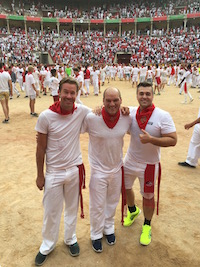
We made it to the finish… ALIVE!!!
The crowd was roaring. Pop, dance, and rock music, both Spanish and American, was blasting throughout the arena. The sangria and beer were already flowing freely, and it was still barely 8:15 in the morning. Exhausted runners, many of whom had already been up all night, filled the earthen-floor arena and were still showing no signs of fatigue. But even if they were, the next part is surely enough to bring about an adrenaline-filled third wind.
After all 12 bulls get herded into the holding area at the Plaza de Toros, one bull at a time is released back out into the arena to charge the hundreds of runners who are ready and waiting there for round two with the bulls. As the arena gate is opened and the bull charges forward at top speed, dozens of people lie on the dirt immediately in front of the gate and form a human mound for the bull to jump over. As the bull approaches the human pyramid, it leaps into the air and clear over the pile of people who get a thrill out of the massive beast flying through the air over their heads and bodies.
Once in the arena, the single bull randomly charges in all different directions as people run and dodge its horns. While the run itself is for the most part forward and linear, the aftershow in the arena is a circular free-for-all. As the bull charges one way and then the next and suddenly the next, swarms of bouncing, dancing, and running participants try to dart out of the way. Some try to reach out and grab the bull’s horns while others even try to mount the bull for a few thrilling seconds as the crowd of thousands in the surrounding stands cheer wildly.
After about 15 minutes, the bull in the arena is ushered back into the corral and another bull is released, again charging through the gate and leaping over the mound of people lying in wait on the ground at the entrance. Music is still blasting throughout the arena while the injured and exhausted leap the barrier to safety or a short rest and then jump back in.
I didn’t see nor have I heard of anyone being seriously injured during this part of the event. The most I saw was a guy with a cut on his arm being bandaged by medics on the sidelines. All of the injuries I’ve heard of have occurred during the actual run, although there must certainly be some during this last part in the arena as well from time to time.
By the time my friends and I had experienced and witnessed all of this craziness, it was still only about 9am. About then is when the crowds from the bullring start to empty back out into the streets for cafe con leche, breakfast, and more festivities. Later in the morning is often when those who have been up all night will return to their homes, flats, and Airbnbs to sleep.

Nom nom nom… eating and drinking sangria all day and night is THE thing to do during San Fermines.
But even as festival goers rest in shifts, the festival itself continues on. Throughout the day and into each subsequent night there are dances in the plazas, bands in the streets, and even huge concerts on stages set up all week. The sangria flows, the fun continues, and the traditions live on.
Keep in mind that this is only about a 24-hour period I’ve been talking about. This same cycle repeats every single day for eight days straight during San Fermines in Pamplona. Every morning there is another Running of the Bulls, another bull-dodging party in the Plaza de Toros at the end of the run, and masses of red and white-clad people packing the streets all day and night.
By now I hope it’s starting to become clear why I say that San Fermines and the Running of the Bulls is without a doubt the most fun and thrilling event I’ve ever been to in all my years of traveling the globe. The event takes place every year on the same dates, July 6th through 14th, and I now have it permanently pinned in my travel calendar as an annually recurring event.
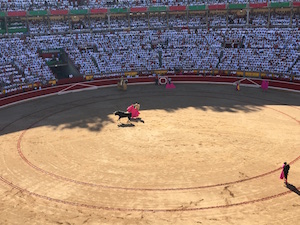
My first and last bullfight in Pamplona´s Plaza de Toros.
One thing I haven’t talked much about and won’t, primarily because I’m personally not a fan of it and don’t want to promote it, is the daily bullfight that takes place every evening during San Fermines. While I’m a huge fan of preserving and celebrating traditions around the world, bullfighting is just not one that I want to highlight. I’ll readily admit that I did go see one bullfight during my first San Fermines experience and I left about halfway through it after seeing quite enough.
While bullfighting has a long tradition in and strong cultural affiliation with Spain (check out the related article on the history of bullfighting entitled Bullfighting: Traditions, Ethics, and Surprises), it has become more and more controversial in recent years, even within Spain, and it has been banned outright in some regions. For now, at least, it remains a part of the daily roster of activities during San Fermines in Pamplona and visitors can decide for themselves if it’s something they want to see and experience or not. I won’t be at the bullfights anymore, but I most certainly will still be at San Fermines.
Even without patronizing this small part of the annual San Fermin festival, surely you understand now that San Fermines is SO much more than that and even so much more than just the Running of the Bulls. It’s a wonderfully rich and incredibly fun experience that is truly a bucket list item for those with a thirst for travel and adventure.
Videos from San Fermines

